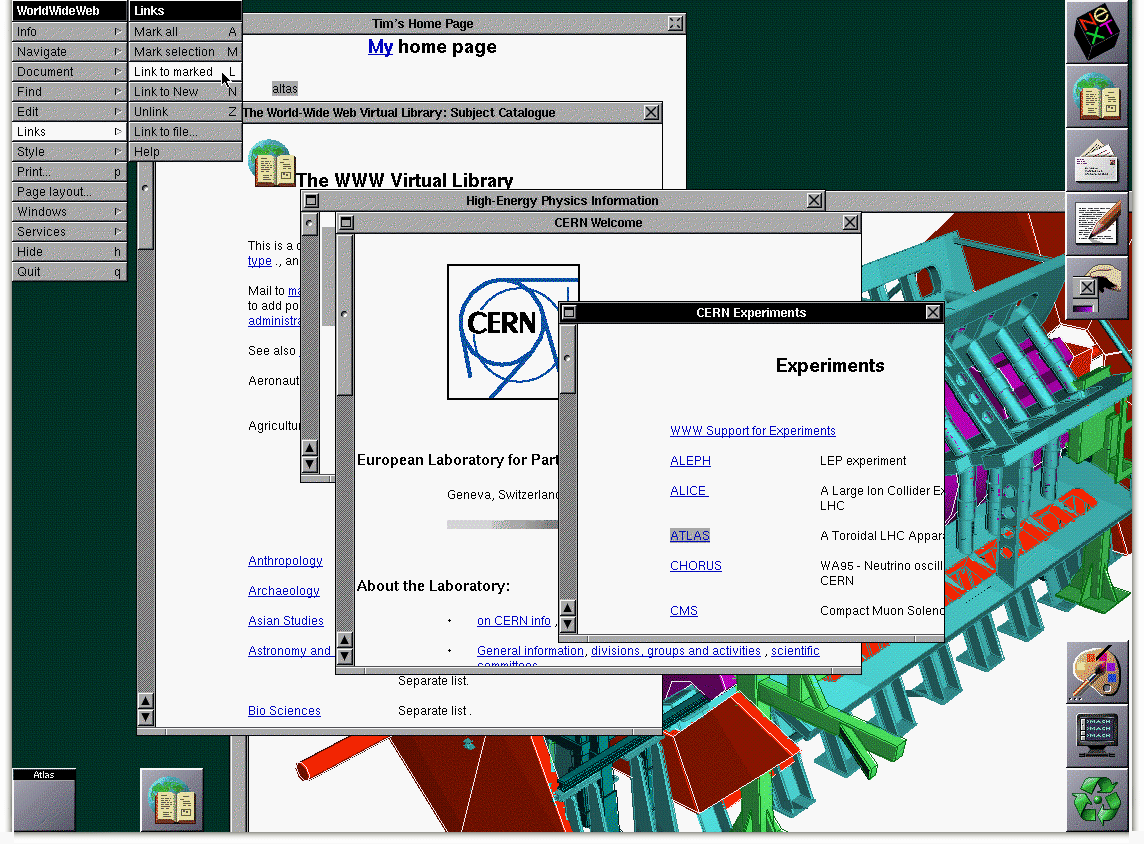Twenty years of a free, open webOn 30 April 1993 CERN published a statement that made World Wide Web technology available on a royalty free basis, allowing the web to flourishOn 30 April 1993 CERN published a statement that made World Wide Web ("W3", or simply "the web") technology available on a royalty-free basis. By making the software required to run a web server freely available, along with a basic browser and a library of code, the web was allowed to flourish.British physicist Tim Berners-Lee invented the web at CERN in 1989. The project, which Berners-Lee named "World Wide Web", was originally conceived and developed to meet the demand for information sharing between physicists in universities and institutes around the world.
Screenshot of the original NeXT web browser in 1993
Other information retrieval systems that used the internet - such as WAIS and Gopher - were available at the time, but the web's simplicity along with the fact that the technology was royalty free led to its rapid adoption and development.
“There is no sector of society that has not been transformed by the invention, in a physics laboratory, of the web”, says Rolf Heuer, CERN Director-General. “From research to business and education, the web has been reshaping the way we communicate, work, innovate and live. The web is a powerful example of the way that basic research benefits humankind.”The first website at CERN - and in the world - was dedicated to the World Wide Web project itself and was hosted on Berners-Lee's NeXT computer. The website described the basic features of the web; how to access other people's documents and how to set up your own server. Although the NeXT machine - the original web server - is still at CERN, sadly the world's first website is no longer online at its original address.
To mark the anniversary of the publication of the document that made web technology free for everyone to use, CERN is starting a project to restore the first website and to preserve the digital assets that are associated with the birth of the web. To learn more about the project and the first website, visit
http://first-website.web.cern.chRead about the restoration projectBrowse the first websiteVinton Cerf on the architecture, connectivity and openness of the webRobert Cailliau on the birth of the web and "How to spread this thing"Continua: http://info.cern.ch/ Vent’anni fa il Cern annunciava
il World Wide Web, Internet per tuttiIl 30 aprile 1993 l’istituto di ricerca rendeva pubblica la tecnologia
ROMA
Il World Wide Web, noto più semplicemente come Web, compie 20 anni di «libertà»: il 30 aprile del 1993 il Cern di Ginevra rendeva infatti pubblica la tecnologia utilizzata e la rendeva disponibile liberamente senza diritti.
Noto con l’acronimo di Www oppure Web, questo servizio Internet fu creato nel 1989 da Tim Berners-Lee, un ricercatore del Cern, per favorire la condivisione delle informazioni tra i fisici di università e istituti di ricerca. Al momento dell’ideazione, il World Wide Web rappresentava soltanto uno dei molti servizi simili disponibili su Internet.
La semplicità d’uso e soprattutto la decisione di renderlo un servizio libero e senza diritti ne portò alla rapida diffusione, tanto da essere oggi il più diffuso standard di trasmissione su Internet.
Per celebrare l’anniversario della pubblicazione del documento che ha reso gratuita la tecnologia Web, il Cern ha avviato un progetto per ripristinare il primo sito della rete, oggi non più in linea, realizzato da Berners-Lee proprio per diffondere l’uso del Web e ospitato su un computer NeXT.
(Ansa)
http://www.lastampa.it/2013/04/30/tecno ... agina.html 




